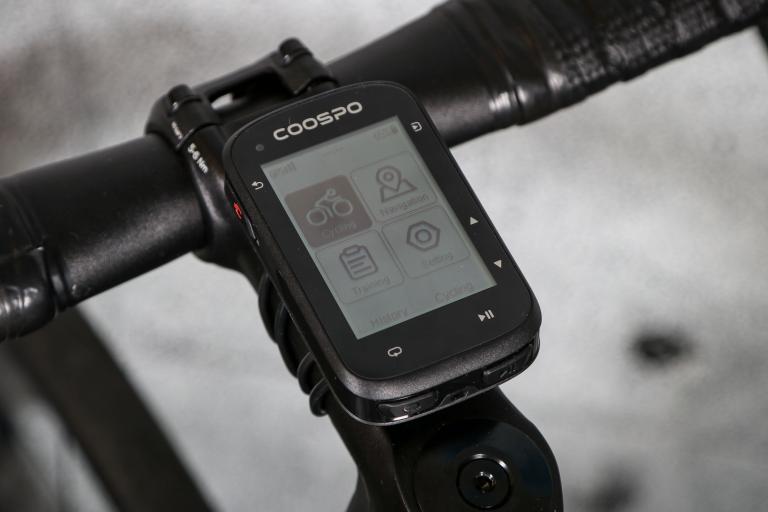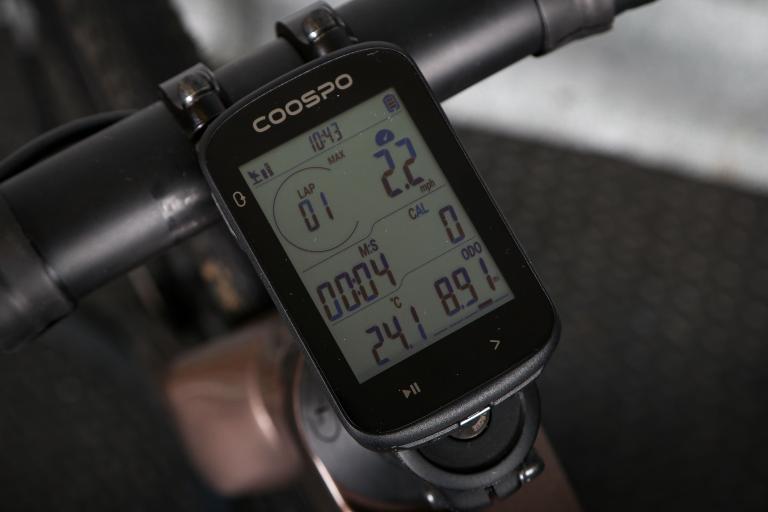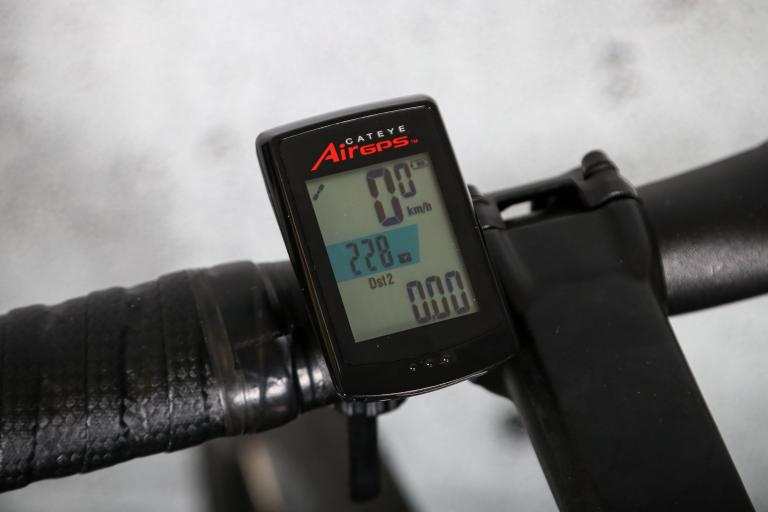- News
- Reviews
- Bikes
- Accessories
- Accessories - misc
- Computer mounts
- Bags
- Bar ends
- Bike bags & cases
- Bottle cages
- Bottles
- Cameras
- Car racks
- Child seats
- Computers
- Glasses
- GPS units
- Helmets
- Lights - front
- Lights - rear
- Lights - sets
- Locks
- Mirrors
- Mudguards
- Racks
- Pumps & CO2 inflators
- Puncture kits
- Reflectives
- Smart watches
- Stands and racks
- Trailers
- Clothing
- Components
- Bar tape & grips
- Bottom brackets
- Brake & gear cables
- Brake & STI levers
- Brake pads & spares
- Brakes
- Cassettes & freewheels
- Chains
- Chainsets & chainrings
- Derailleurs - front
- Derailleurs - rear
- Forks
- Gear levers & shifters
- Groupsets
- Handlebars & extensions
- Headsets
- Hubs
- Inner tubes
- Pedals
- Quick releases & skewers
- Saddles
- Seatposts
- Stems
- Wheels
- Tyres
- Health, fitness and nutrition
- Tools and workshop
- Miscellaneous
- Cross country mountain bikes
- Tubeless valves
- Buyers Guides
- Features
- Forum
- Recommends
- Podcast
review
£179.99
VERDICT:
Well-made GPS unit with good range of data and built-in UK mapping. Feels a bit like a work in progress at times.
Weight:
108g
Contact:
www.brytonsport.com
At road.cc every product is thoroughly tested for as long as it takes to get a proper insight into how well it works. Our reviewers are experienced cyclists that we trust to be objective. While we strive to ensure that opinions expressed are backed up by facts, reviews are by their nature an informed opinion, not a definitive verdict. We don't intentionally try to break anything (except locks) but we do try to look for weak points in any design. The overall score is not just an average of the other scores: it reflects both a product's function and value – with value determined by how a product compares with items of similar spec, quality, and price.
What the road.cc scores meanGood scores are more common than bad, because fortunately good products are more common than bad.
- Exceptional
- Excellent
- Very Good
- Good
- Quite good
- Average
- Not so good
- Poor
- Bad
- Appalling
Bryton are a new player in the GPS market and their Ryder 50 is a colour unit with full UK mapping built in. It's a bit rough round the edges in terms of the software side, and feels a bit like a work in progress at times, but performance is generally good and the unit itself is solidly built and fairly easy to use.
Open the box and out tumbles the GPS unit, a mount, a charger and assorted gubbins. First impressions are of a nicely-made bit of kit, it feels solid enough and switching it on for the first time reveals that the screen is good quality. Don't expect a super-fine screen like your smartphone; those eat power and aren't much good for units like these. The TFT is clear enough without a backlight, pressing the 'return' button (or using any of the controls) will fire up the light for a clearer view.
You get the usual array of functions here. You can track your route on a map, or follow a route you've uploaded. There's speed and distance functions, altitude (via a barometer), a compass, averages, stopwatches and timers. You can train with intervals, or race against yourself, either at a preset speed or against a recorded track. There's a step counter for jogging and walking and you can add HRM and cadence data with optional sensors. All of the recorded information can be fed back to the Bryton website via the BrytonBridge application, which installs the first time you plug the unit into your PC. A Mac version of the Bridge software is on the way.
The original mount that came with the Rider 50 was a bit flimsy; okay for road riding but not for offroad excursions. Bryton have revised the mount though, and the second one we received (a stem mount with overlapping O rings, a bit like the latest Garmin ones) was much better. Stick it on the bike and off you go; you can follow your progress on screen.
Mapping wise the Rider 50 uses OpenStreetMap to cover the UK. This mapping has the benefit of being free and open source, and it's constantly updated by users. That's the plus points: on the negative side it's simply not as accurate as Ordnance Survey. I used the Rider 50 on- and off-road and while I was expecting to find that some of the local trails wouldn't be on the map, I was at least expecting all the roads to be there. However I did at times find myself cycling over blank space on the map, even though I was very much on tarmac. If I was a more conscientious OpenStreetMap user I'd import my GPX file into the editing system and add the missing road. I'm not though; I'd rather the mapping was just right in the first place. The other issue is the the trails aren't as easy to decipher as on OS maps; bridleways look like byways look like footpaths. That might just be a familiarity thing.
In use the Bryton unit is fairly simple, although the buttons on the side of the unit are hard to access with gloved fingers. On top of that there's quite a lag – as much as a second – between hitting the button and the screen updating. Add those two things together and you're never really sure whether you've pressed or not, which can be frustrating. The chipset is very good; sensitivity is excellent and the Rider 50 hardly ever lost contact with the satellites, even in some pretty thick woods. Battery life is good too – ours ran for about 12 hours before giving up the ghost – but it's frustrating that the unit doesn't power down or sleep when it's not being used.
The Bryton Bridge software, and the Bryton website itself, underwent major revisions during the time that I was testing the unit; it's a hard life being an early adopter. The firmware on the unit was under constant revision too, meaning that each plug-in of the Rider 50 meant some lengthy waits downloading updates for the unit, or the bridge software, or both.
To Bryton's credit the installation process was straightforward and the updates were all improvements. For instance, the final update of the unit added another data screen in a different configuration, and with both data screens fully customisable it effectively doubled the amount of information you could display. The Bryton website is reasonably slick too, though I'd prefer that the default setting for routes was private rather than public, seeing as how they all start from my house. On the website you can view all your data, and the public data of other users, download GPX files and keep track of your training.
Perhaps unsurprisingly I found that I was constantly comparing the Bryton with Garmin units. In effect it falls between the Edge 705 and the Edge 800; it's like a 705 with better mapping, although it's not capable of displaying as much user data; not, at least, until the next update which may well add yet another data screen. Garmin have really upped their game with the Edge 800 though, and the Bryton doesn't get close to the new unit in terms of ease of use or mapping clarity. An Edge 800 with UK mapping is going to hit you for £400 though, and you can have a Rider 50 for less than half that, and less than a 705 as well.
It's horses for courses really. If you're really going to be relying on the mapping and it's your primary concern then you'd be better off biting the bullet and going for a Garmin Edge 800; that's the benchmark unit in terms of overall performance and map clarity. If that's not so much of an issue and you just want to keep track of your training with the maps as a backup, then the Rider 50 makes more sense - there's also an uprated version with an integrated heart rate monitor for £255 (though shop around and you can get it for less). You'll have to weigh it up against a Garmin Edge 705, which has a more developed online community and is generally slicker although possibly not as easy to use out of the box, and a bit more expensive. The pace of development at Bryton – both firmware and software – suggests that the Rider 50 will continue to improve. As it is, it's certainly worth a look.
Verdict
Well-made GPS unit with good range of data and built-in UK mapping. Feels a bit like a work in progress at times.
road.cc test report
Make and model: Bryton Rider 50 GPS computer
Size tested: blue
Tell us what the product is for, and who it's aimed at. What do the manufacturers say about it? How does that compare to your own feelings about it?
Bryton Rider 50 is a GPS cycling computer designed for cyclists of all levels. You can personalize your preferred settings with 33 options of display information. Brytonsport.com provides you a cyclist's playground where you can share cycling and training results, join teams for games or competition and explore new horizons.
Tell us some more about the technical aspects of the product?
• Model: Bryton Rider 50
• GPS: High-Sensitivity Chipset
• Display: 2.2 Color Transflective TFT
• Waterproof: IPX7 (Against water immersion for 30 mins at a depth of 1m)
• Device Weight: 106 g
• Device Dimension: 54.7 X 96 X 21.6 mm
• Accepted Data Card: micro SD Card
• Battery: Rechargeable Lithium Battery (Max 15 hours usage)
• Wireless Interface: 2.4 GHz ANT+
• Connection Interface: Mini USB
• Coordinate Format: GWS84 (Degrees/Minutes/Seconds, Decimal Degrees)
• Record POI: 10,000 points
• Log History: 10,000 km
• Training Options: 6 modes (Fitness/Simple/Advanced/Zone Based*/Interval*/Lap*)
• My Buddy: Yes
• Barometer: Yes
• Digital Compass; Yes
• Operating Temperature: -15C° ~50 C°
• Map: Preloaded Detailed Maps, POIs and Bike Routes**
Rate the product for quality of construction:
7/10
solidly built, the original mount was poor but the replacement better
Rate the product for performance:
7/10
Pretty good, limited a bit by the mapping
Rate the product for durability:
7/10
No issues on test, waterproofing is effective
Rate the product for weight, if applicable:
8/10
Comparable to other similar units
Rate the product for value:
6/10
Cheaper than a Garmin but not quite as good. You pays your money...
Tell us how the product performed overall when used for its designed purpose
Pretty well
Tell us what you particularly liked about the product
Good screen and battery life, sensitive GPS
Tell us what you particularly disliked about the product
fiddly buttons, mapping isn't as good as OS, constant updates are a bit annoying.
Did you enjoy using the product? Yes most of the time
Would you consider buying the product? I'd probably still go for a Garmin
Would you recommend the product to a friend? Maybe
About the tester
Age: 38 Height: 190cm Weight: 98kg
I usually ride: whatever I'm testing... My best bike is: Genesis Equilibrium with SRAM Apex
I've been riding for: 10-20 years I ride: Every day I would class myself as: Experienced
I regularly do the following types of riding: time trialling, cyclo cross, commuting, sportives, general fitness riding, fixed/singlespeed, mtb, Mountain Bike Bog Snorkelling, track
Dave is a founding father of road.cc, having previously worked on Cycling Plus and What Mountain Bike magazines back in the day. He also writes about e-bikes for our sister publication ebiketips. He's won three mountain bike bog snorkelling World Championships, and races at the back of the third cats.
Latest Comments
- BigSigh 5 hours 11 min ago
I am absolutely certain that it's not fair for trans-identifying males who went through male puberty to compete in female sports... and that should...
- thax1 5 hours 14 min ago
I was just excited to learn that Grundig were still a going concern, let alone making stuff for bikes now! What's next, Blaupunkt power meters?!
- chrisonabike 6 hours 25 min ago
Nothing to do with cycling, and currently unclear as to what exactly happened. But a child is dead, a tram line isn't running services and ...
- Destroyer666 5 hours 39 min ago
Sidelining the point here a little bit, but I was just looking at a Rapha video about Lachlan Morton's latest incredible venture of riding 648km in...
- wtjs 9 hours 17 min ago
Or, you can just look at them - it's pretty obvious when they're not going to work with a new chain. Then you can try them with old lengthened...
- NeilC575 9 hours 20 min ago
I bought 5 screw in storage hooks from local d.i.y store for £10. Does the same job 🤷♂️
- Bungle_52 13 hours 4 min ago
Well it looks like they've got a page now. It says they'll accept video evidence but I haven't been through the whole process. Looks very similar...
- eburtthebike 13 hours 13 min ago
Sorry, but the BBC is definitely tilting towards cycling after the Panorama debacle....
- mdavidford 13 hours 19 min ago
Unlikely. Not once he hears that it'll 'help Gore'.










Add new comment
5 comments
Saw this at the Cycle Show last year. Liked their approach, and will be interesting to see the product develop. Looks like Garmin might have some competition...
As Fred22 points out, it would be great if the hardware was off the shelf and then the firmware and software was open source.
I think this sounds great. Given the many long-standing issues with all versions of garmin then maybe some competition will focus their minds. And I love the idea of Open Source mapping, though it's relatively early days. It's just what we need actually, in fact I'd in further. What we need is just the hardware, then I'd like them to release the software into the community like linux or firefox. There's enough clever cyclists about to maintain it and the maps
Im not aware of any 'long atanding issues' of garmins, infact my 2 and my friends all work fine, and always have. And open source mapping is easy enough to add onto a garmin 705 though as mentioned in the review some bits may be missing (i found/lost an entire village on the yorkshire coast last summer!). I dont see this as a masssive problem really as i always check routes on paper maps or google or bikeroutetoaster before i venture anywhere new.
nope, just a country road i use a lot on my routes from home. to be fair it's the only one i've found thus far, and i've used openstreetmap a fair bit. off road routes are significantly less well mapped.
I like the idea of free mapping installed out of the box.
I've looked at the online version of OpenStreetMap and it seems pretty comprehensive, at least for Essex, where I live.
Was the road you found that wasn't there, a new road?
I wonder how accurate the openstreetmap is, if its 99% then I dont think its an issue.
I'm not interested in off road.
Thanks for the review, hopefully there'll be a few online stores selling these and it'll get competitive soon.